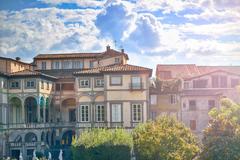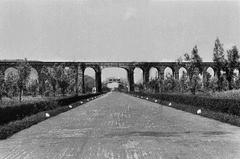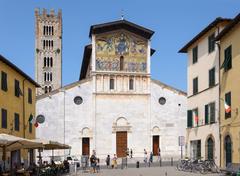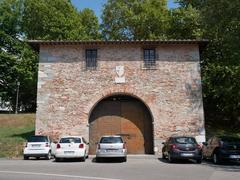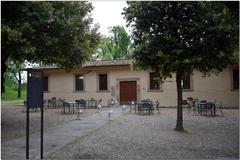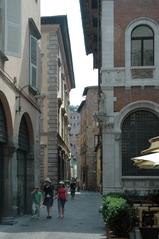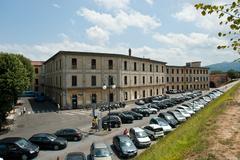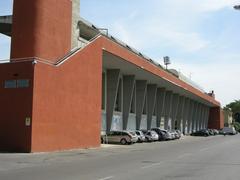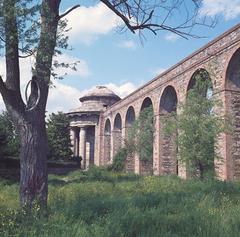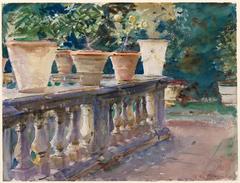
Palazzo Pfanner: Visiting Hours, Tickets, and Historical Significance
Date: 19/07/2024
Introduction
Nestled in the heart of Lucca, Italy, Palazzo Pfanner is a captivating blend of history, architecture, and horticultural beauty. This iconic site, once a bustling silk factory, evolved into a grand symbol of wealth and prestige through the centuries. From its origins in the 17th century to its current status as a cultural gem, Palazzo Pfanner offers visitors a glimpse into the rich tapestry of Lucca’s past. The palazzo’s transformation reflects the city’s transition from a medieval stronghold to a beacon of Baroque opulence, and later, a Romantic retreat. Whether you’re a history enthusiast or a lover of fine gardens, Palazzo Pfanner promises an enriching experience. This guide provides an in-depth look at its storied history, architectural significance, and essential visitor information, ensuring you make the most of your visit to this enchanting destination (Palazzo Pfanner official website).
Table of Contents
Historical Background
Origins and Early Transformation
Palazzo Pfanner’s roots trace back to 1660, when it was constructed upon the foundations of a pre-existing medieval tower house. This earlier structure, likely dating back to the 14th century, can still be glimpsed in the palazzo’s layout and some remaining elements.
Initially, the palazzo served a practical purpose as a silk factory, reflecting Lucca’s thriving silk industry during that era. The building’s design, with its spacious rooms and ample light, was well-suited for the silk production process.
The Moroni Family and Baroque Influence
In 1680, the Moroni family, a prominent noble family of Lucca, acquired the property. This marked the beginning of the palazzo’s transformation from a place of industry to a symbol of wealth and prestige.
The Moroni family embarked on an extensive renovation project, aiming to elevate the palazzo to reflect their status. They enlisted the expertise of local craftsmen and artisans, imbuing the building with the prevailing architectural style of the time – Baroque.
The Baroque influence is evident in the palazzo’s grand staircase, a masterpiece of design and craftsmanship. Its sweeping curves, intricate balustrades, and decorative elements exude elegance and grandeur, showcasing the opulence favored during the Baroque period.
The Pfanner Era and the Romantic Garden
The 19th century ushered in another significant chapter in the palazzo’s history with the arrival of Felice Pfanner, a brewer from Austria, in 1846. Pfanner, drawn to Lucca’s beauty and tranquility, purchased the palazzo, which had been vacant for several years.
While preserving the existing structure and its historical elements, Pfanner focused his attention on the palazzo’s outdoor space. He envisioned a garden that would harmoniously blend with the surrounding landscape and provide a serene retreat.
Inspired by the Romantic movement’s ideals, Pfanner commissioned the creation of what is now known as the Giardino Pfanner, or Pfanner Garden. This enchanting garden, designed in the English Romantic style, became an integral part of the palazzo’s allure.
Architectural Significance
Baroque Facade and Staircase
Palazzo Pfanner stands as a captivating example of Baroque architecture in Lucca, seamlessly blending with elements of its earlier medieval past. The palazzo’s architectural significance lies in its harmonious fusion of different styles and periods.
-
Baroque Facade and Staircase: The palazzo’s facade, while relatively understated, features elegant Baroque details, particularly around the windows and the main entrance. The true Baroque masterpiece lies within – the grand staircase. Its sweeping design, intricate ironwork, and decorative motifs exemplify the grandeur and theatricality characteristic of the Baroque style.
-
Medieval Remnants: Despite the Baroque renovations, remnants of the palazzo’s medieval origins are still visible. The most prominent is the ancient tower, integrated into the building’s structure. This tower, a reminder of Lucca’s fortified past, adds a layer of historical intrigue to the palazzo.
-
The Romantic Garden: The Giardino Pfanner, a testament to 19th-century Romantic ideals, complements the palazzo’s architectural narrative. Its design, characterized by lush vegetation, winding paths, and a central fountain, creates a sense of tranquility and harmony with nature.
Visitor Information
Tickets and Visiting Hours
To explore the rich history and stunning architecture of Palazzo Pfanner, visitors can purchase tickets at the entrance or online. The palazzo is open to the public from April to November, with visiting hours typically from 10 AM to 6 PM. It is advisable to check the official Palazzo Pfanner website for the most up-to-date information on ticket prices and visiting hours.
Guided Tours and Special Events
For an in-depth experience, guided tours are available, offering detailed insights into the palazzo’s history and architectural features. Palazzo Pfanner also hosts special events throughout the year, including art exhibitions, concerts, and cultural festivals. Keep an eye on the official website for upcoming events and booking information.
Travel Tips and Nearby Attractions
Located in the heart of Lucca, Palazzo Pfanner is easily accessible by foot or bicycle. The city of Lucca itself is a treasure trove of historical sites, including the famous Lucca Walls, the Guinigi Tower, and the Cathedral of San Martino. Visitors can also enjoy the charming streets, cafes, and shops that make Lucca a delightful destination.
Conclusion
Palazzo Pfanner stands as a testament to Lucca’s rich cultural heritage and architectural splendor. From its Baroque architecture to its lush Romantic gardens, every corner of the palazzo tells a story of transformation and elegance. A visit to Palazzo Pfanner is more than just a tour; it’s an immersive journey through time that offers insights into the lives and legacies of its past inhabitants. Whether you are captivated by its historical background, the artistic beauty of its gardens, or the detailed craftsmanship within its walls, Palazzo Pfanner is sure to leave a lasting impression. Be sure to check the official Palazzo Pfanner website for the latest information on visiting hours, ticket prices, and special events to enhance your visit. Embrace the opportunity to explore this architectural gem and immerse yourself in the timeless beauty of Lucca.
FAQ
Q: What are the visiting hours for Palazzo Pfanner? A: Palazzo Pfanner is open from April to November, typically from 10 AM to 6 PM. Check the official website for the most current information.
Q: How much do tickets cost? A: Ticket prices vary and can be purchased at the entrance or online. For the latest pricing, visit the official website.
Q: Are guided tours available? A: Yes, guided tours are available and provide detailed insights into the palazzo’s history and architecture. Check the official website for tour schedules and booking information.
Q: What other attractions are nearby? A: Nearby attractions include the Lucca Walls, Guinigi Tower, and Cathedral of San Martino. Lucca’s charming streets, cafes, and shops also offer a delightful experience.
